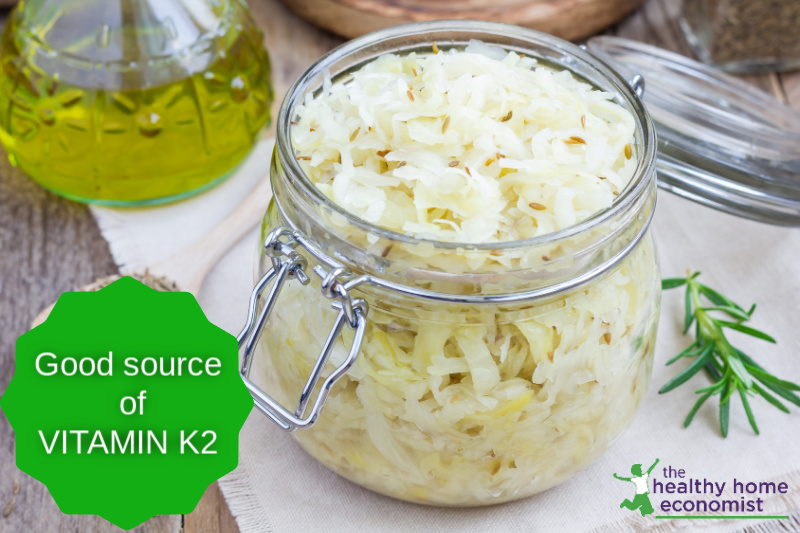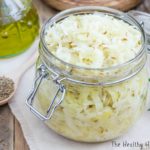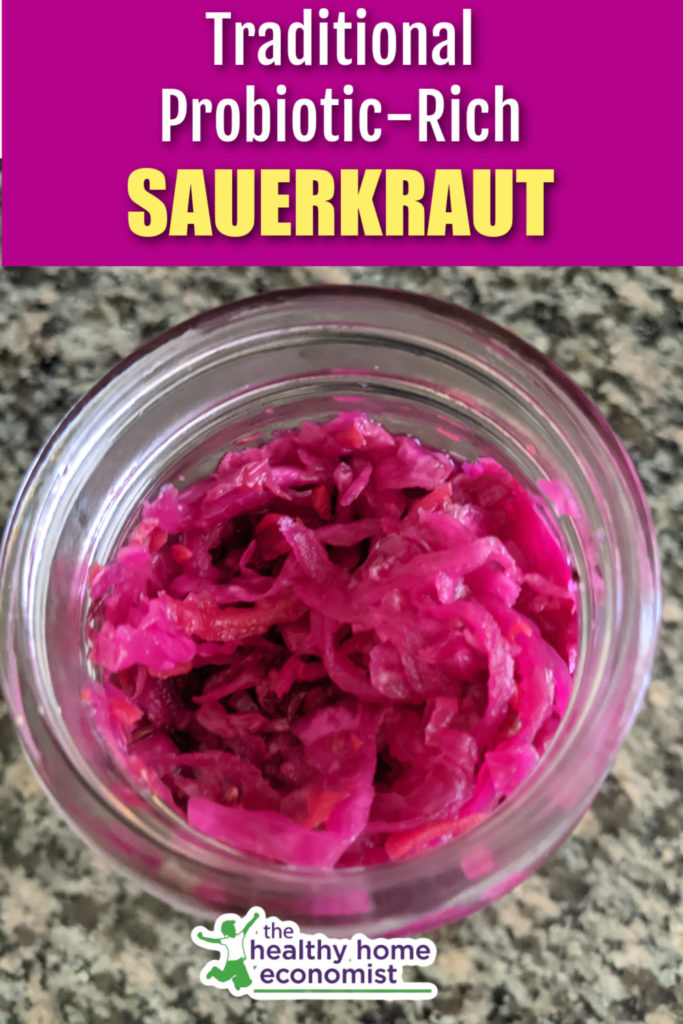Recipe and detailed video instruction on how to make traditional sauerkraut that is loaded with probiotics and Vitamin K2 for better digestion and health. 
By popular demand, the process of making homemade sauerkraut is explained and demonstrated in the two video lessons below. The written recipe is also provided by those who wish to dive right in.
This traditional food is probiotic-rich and very nutrient-dense unlike the vinegar-packed sauerkraut wanna-be’s at the store.
The first video covers a brief history of sauerkraut and what you need on hand to make it. The second video covers how to make sauerkraut yourself quickly and easily in your kitchen.
The sauerkraut recipe I use is based on the Nourishing Traditions method.
Benefits of Fermenting Cabbage
Eat small amounts of this probiotic-rich condiment with cooked foods to improve digestion and assimilation.
Remember that fermenting does not reduce the goitrogens (thyroid suppressing substances) in the cabbage. So, if you have thyroid issues, you may wish to consider avoiding this particular condiment.
If your thyroid status is good and you eat plenty of iodine-rich foods like grassfed butter, then sauerkraut is a healthy addition to the diet.
Loaded with Vitamin K2
Did you know that properly cultured cabbage contains a significant amount of natural Vitamin K2? This is an elusive nutrient that is very hard to get in the diet. It is essential for strong bones and healthy teeth.
The USDA reports that one cup of sauerkraut contains 81 mcg. No doubt this is the commercial, pasteurized stuff that the USDA is testing too.
I would venture to suggest that making raw sauerkraut yourself and fermenting properly would potentially contain larger amounts.
Natural Remedy for Reflux
Another bonus of eating raw fermented cabbage is that it is a natural way to prevent acid reflux. Simply eat a mouthful or two a few minutes before the start of a meal.
Want to experience these benefits for yourself? Two detailed video lessons are included with the recipe below.
Tip: Be sure to wear an apron when you make this dish as you will see in the video! ?
Why don’t you try it today! You will never go back to the pasteurized, shelf stable sauerkraut at the store!

Homemade Sauerkraut Recipe
Basic recipe for homemade sauerkraut as traditionally made as a live cultured food loaded with probiotics and enzymes to aid digestion and absorption of nutrients.
Ingredients
- 1 green or purple cabbage medium size, preferably organic
- 4 Tbl liquid whey
- 1 Tbl caraway seeds
- 1 Tbl sea salt
Instructions
-
Core and chop cabbage. Place all the chopped cabbage and other ingredients together in a large sturdy bowl.
-
Pound the juices out of the cabbage thoroughly with a kitchen pounder of some kind for a full 10 minutes.
-
Tightly pack the cabbage into a one quart mason jar leaving at least 1 inch of space at the top. Tightly seal with the lid.
-
Leave on the counter for 3 days and then refrigerate.
-
The flavor of the homemade sauerkraut improves over time. It will last many months in your refrigerator or cool cellar.
Recipe Video

References
(1) Vitamin K2 in Sauerkraut
(2) Nourishing Traditions
More Fermented Food Recipes
Love this sauerkraut recipe? Try these other delicious fermented foods and drinks below and unleash the power of a traditional diet in your home.
How to Make Fermented Lemonade
How to Make Orangina
Mango Chutney Recipe
Homemade Apricot Butter
Fermented Potatoes
Probiotic Corn Relish
How to Make Fermented Cilantro Salsa
Beet Kvass Recipe








Hurray for your kimchi addiction, we have made that when my Korean mother-in-law visits. So many variations of kimchi. We keep our 10+ jars in a wine fridge (less wine since parenthood). Thanks for the video, my first attempt at sauerkraut did not go well, I will try it again now.
Hi Kim, you can start eating right away after it is fermented on the counter for 3 days. The flavor just improves over time – peaking at 6 months but you can surely eat it right away after it is done fermenting!
Sarah, I think I missed out on how long until you eat the sauerkraut! I know you said the flavor improves, but do you have to wait for months while it is in your refrigerator?
I've made the Nourishing Traditions sauerkraut a bunch of times, and it always turns out delicious, though slightly different in flavor every time. Not sure why 🙂
I haven't been able to find organic powdered whey locally, so I just drain some yogurt and use the liquid. What kind do you use?
I am new to traditional cooking, also, but I have bought raw nuts from bulkfoods.com They are relatively cheap compared to smaller sizes at the store. They have $5 shipping for large orders, also. Hope this helps!
Hi Ali, I buy most of my nuts at the healthfood store. I buy pecans and almonds in bulk from a buying club when they are in season. I haven't used stevia for ice cream – if you try it, please comment again with the results of how you liked it!
I really appreciate all the effort you put into your videos, they extremely easy to follow and very educational. I came across Nourishing traditions about 12 months ago and am trying to implement many of the ways real food is prepared. It has been difficult as I am not what you would call very good in the kitchen( my husband is very good), but watching your videos and reading your blogs has given me encouragement and made it easier to attempt things that I thought were too hard or complicated.
Thank you so much. Penny
Sarah – This is off the subject of this post (though I'm excited to use the liquid whey sitting in the fridge). I was wondering, where do you buy nuts? Do you order them and buy them in bulk? They are quite expensive just getting a bag of them at the grocery store!
Also, have you used stevia in homemade ice cream? I'd like to give it a try but I thought I'd ask you first. Thanks!
It's funny, many people are afraid to try fermented foods, but when I was about 16 my sister and I found a recipe for sauerkraut very similar to this in one of my mom's cookbooks and we decided to give it a try. We could not believe how good it was! Definitely 100 times better than the store bought version! My sister won't even touch store bought sauerkraut anymore because she says it has a "taste" (probably the vinegar). (My mom, on the other hand, has never been a fan of sauerkraut and she wasn't convinced even with the homemade version:) Oh well…) So if any of you out there are afraid to try fermented foods, don't be! Seriously, the bacteria basically does all the work for you. And I've been told that you don't have to worry about poisoning your family either. If you do have a batch that goes "bad" – which is really hard to do – you will DEFINITELY know!
P.S. I live in Canada and I made sauerkraut a few months ago (when there was still snow on the ground). I found that I had to leave it on the counter for about 2 weeks before it looked right, but I also have a very cold house and we have a very dry climate here. Temperature, and probably humidity too, have a big impact on how fast it ferments, so go by looks. If it still looks like cabbage then it's not ready.
I will give this a try soon. I've never liked saeurkraut but I'm wondering if it was just the industrial version I didn't like. Never had real home made. Thank you for the video and the history – love it!
Questions: what all do you do with the sauerkraut? Can you give some serving suggestions? Also, once you move it to the fridge how soon can you eat it?
I made kim chi this past weekend. I have a Korean friend who encouraged me (and gave me a bunch of ingredients!). Mine isn't as good as hers (of course) but it was fun to make. I'll try to post a blog about it soon if you are interested. My blog is http://www.kitchenkungfu.wordpress.com